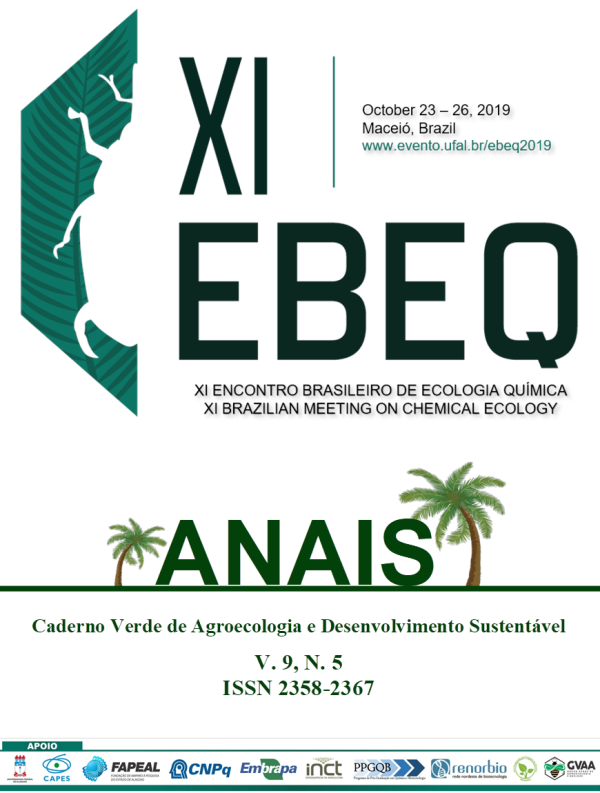IMPROVING THE BLEND: ADDITIONAL BEHAVIOURALLY ACTIVE GLAND CONSTITUENTS IDENTIFIED IN FEMALE Diatraea Saccharalis (LEPIDOPTERA: CRAMBIDAE)
Palavras-chave:
Diatraea Saccharalis, SEX PHEROMONE, ELECTROPHYSIOLOGY, WIND TUNNEL ASSAYS, (Z)-HEXADEC-9-ENAL, HEXADECANAL.Resumo
The sugarcane borer, Diatraea saccharalis (Fabricius) (Lepidoptera: Crambidae), is the major pest insect attacking sugarcane crops in Brazil. Population control of this moth by insecticide treatment is not efficient due to simultaneous presence of all developmental stages throughout the year, and larval feeding inside the sugarcane stalk, so alternative control methods are needed. Two female-produced sex pheromone components, (Z,E)-hexadeca-9,11-dienal and (Z)-hexadec-11-enal, have previously been reported to elicit antennal activity and behavioural response of males in flight tunnel experiments. However, the attractiveness of these compounds in field tests has been very low. Via chemical, electrophysiological and behavioural analyses, we have identified two additional female-produced compounds in D. saccharalis, which are active to conspecific males, as (Z)-hexadec-9-enal and hexadecanal. In analyses with coupled gas chromatography and electroantennography, these compounds elicited consistent antennal response in males. In flight tunnel assays, the behavioural response to a quaternary blend was significantly higher when compared with the previously identified binary blend. In addition, the ternary mixtures containing (Z)-hexadec-9-enal or hexadecanal were as attractive as the quaternary blend, indicating some redundancy in the use of active compounds in this species. We conclude that additional compounds are part of the sex pheromone of D. saccharalis, which may improve the efficiency of trap lures for monitoring of this pest.Downloads
Publicado
Como Citar
Edição
Seção
Licença
Termo de cessão de direitos autorias
Esta é uma revista de acesso livre, em que, utiliza o termo de cessão seguindo a lei nº 9.610/1998, que altera, atualiza e consolida a legislação sobre direitos autorais no Brasil.
O(s) autor(es) doravante designado(s) CEDENTE, por meio desta, publica a OBRA no Caderno Verde de Agroecologia e Desenvolvimento Sustentável, representada pelo Grupo Verde de Agroecologia e Abelhas (GVAA), estabelecida na Rua Vicente Alves da Silva, 101, Bairro Petrópolis, Cidade de Pombal, Paraíba, Brasil. Caixa Postal 54 CEP 58840-000 doravante designada CESSIONÁRIA, nas condições descritas a seguir:
O CEDENTE declara que é (são) autor(es) e titular(es) da propriedade dos direitos autorais da OBRA submetida.
O CEDENTE declara que a OBRA não infringe direitos autorais e/ou outros direitos de propriedade de terceiros, que a divulgação de imagens (caso as mesmas existam) foi autorizada e que assume integral responsabilidade moral e/ou patrimonial, pelo seu conteúdo, perante terceiros.
O CEDENTE mantêm os direitos autorais e concedem à revista o direito de divulgação da OBRA, com o trabalho simultaneamente licenciado sob a Licença Creative Commons do tipo atribuição CC-BY.
O CEDENTE têm autorização para distribuição não-exclusiva da versão do trabalho publicada nesta revista.
O CEDENTE têm permissão e são estimulados a publicar e distribuir seu trabalho online (ex.: em repositórios institucionais ou na sua página pessoal) a qualquer ponto antes ou durante o processo editorial, já que isso pode gerar alterações produtivas, bem como aumentar o impacto e a citação do trabalho publicado.










